Luis Maria B. Garcia
Aquaculture Department,
Southeast Asian Fisheries Development Center (SEAFDEC),
Tigbauan, Iloilo, Philippines
Introduction
Milkfish (Chanos chanos Forskal) is one of the most important food fish species in the world. In Indonesia, Taiwan and the Philippines, more than a quarter of a million tonnes of milkfish are harvested annually in brackish ponds, contributing roughly 60% of the total fish production from aquaculture in Southeast Asia. This tremendous level of production from a single fish commodity is projected to further increase in the coming years to meet the dietary protein needs of an ever-growing population in Southeast Asia. To address vital research gaps afflicting the milkfish industry, research has correspondingly intensified over the past 15 years particularly in the Philippines, Taiwan and Hawaii. Results of such research projects have widespread application not only among Southeast Asian nations but also among many untapped areas in the Pacific, the Middle East, Africa and Central America where milkfish culture is feasible.
A sound approach to initiate a milkfish aquaculture project is to have an adequate knowledge of the basic biology of this species. Several researchers have presented in great technical detail some of these biological aspects at numerous symposia (Juario et al., 1984, Lee, Gordon and Watanabe, 1986). This paper will therefore summarize in moderate detail some recent additional information on several aspects of milkfish biology: taxonomy, distribution, life history and habitat, food and feeding habits, growth, reproduction and tolerance to environmental conditions. Aside from increasing our understanding of milkfish, it is hoped that this short review will goad others to undertake further scientific research on many unknown aspects of the species, thus contributing to both the quality and the quantity of milkfish served on our dinner tables.
Taxonomic Classification
| Phylum Chordata |
| Subphylum Vertebrata |
| Class Osteicthyes |
| Order Gonorhynchiformes |
| Family Chanidae |
| Genus Chanos Lacepede 1803 |
| Species Chanos chanos Forskal 1775 |
Milkfish is the only member of the family Chanidae. Chanos was elevated to the generic level by Lacepede in 1803. Although Kluzinger was the first taxonomist to use the name Chanos chanos in 1871, it was the Danish biologist, Petrus Forskal, who initially described it as a type of mullet and therefore named it Mugil chanos in 1775.
Milkfish was formerly synonymous with eighteen other names owing largely to apparent geographic variations of the type specimens described. However, the credit associated with the presently accepted scientific name of milkfish belongs to Forskal.
Fischer and Whitehead (1974) gave a simple and clear description of milkfish. “Body elongate, moderately compressed, without scales along belly. Adipose tissue covering eye. Four branchiostegal rays. Maxilla short, not reaching back beyond eye center; lower jaw with symphysial tubercle. Supramaxillae not present. Not gular plate. Dorsal and anal fins with basal sheath of scales; large axillary scale at base of pectoral and pelvic fins; caudal fin deeply forked. Small scales, cycloid (smooth); lateral line present. Color: back olive green, side silvery. Dorsal and caudal fins with black margin. Inside of pectoral and pelvic fins dark” However, there are two morphological characteristics which previous authors have overlooked in past descriptions of milkfish: the presence of small, thin flaps at the central portion of each side of the caudal fin and the line of small, thin scale-like flaps on the dorsal aspect of the caudal peduncle. The function(s) of these structures are not presently known.
Morphological variations from normal shaped milkfish have been reported. Dwarf and hunch backed (shad-type) and goldfish-type specimens of milkfish have been encountered although their incidence is quite rare.
Although the number of scales and vertebrae are similar to the normal type, a length: depth ratio of 2.0 to 2.5 among these variants was significantly lower than the normal ratio of about 3.5. Senta and Kumagai (1977) also observed that vertebral numbers of milkfish fry caught from various localities tend to increase from west to east. Hence, four groups were reliably distinguished as belonging to India, Thailand, Indonesia-Philippines-Taiwan and Polynesia. The genetic basis of these morphological variations is not well understood.
Distribution
Milkfish occurs near coasts and islands in the tropical Indo-Pacific area and is largely centered around the Philippines and Indonesia. Milkfish do not inhabit areas of the Pacific Ocean influenced by cold currents but they do occur in seas affected by warm ocean currents. Their distribution coincides with coral reef areas where the water is warm (more than 20°C), clear and shallow.
It is thought that there are distinct sub-populations of milkfish. Winans (1980) indicated that Hawaiian populations of milkfish are distinct from the Philippines and the equatorial Pacific populations. Together with the four populations identified by Senta and Kumagai (1977), there are five other populations of milkfish in the Indo-Pacific area alone. Based on meristic variations, separate populations of milkfish have been recorded from several localities in the Philippines. Differences in the morphology and length-weight relationships of milkfish are a reflection of these distinct populations.
Life History and Habitat
Milkfish eggs float and are pelagic since spawning of wild adults is thought to occur in the open sea. Observations by Delsman (1929) of milkfish eggs collected from the Java Sea have been recently confirmed when eggs were obtained at SEAFDEC following spawning induction of wild adult milkfish (Chaudhuri et al., 1978). Fertilized milkfish eggs are spherical and measure from 1.10 to 1.25 mm in diameter. Oil globules are lacking and the chorion appears granular with a fine segmentation pattern. The yolk has a light yellow tinge. A very narrow perivitelline space is present.
Embryonic development follows the usual course of teleost eggs (Chaudhuri et al., 1978; Liao et al., 1979). Incubation periods until hatching vary from 20 to 25 hours after fertilization at 26 to 32°C and 29 to 34 ppt salinity.
Milkfish egg collection data from the west coast of Panay Island, Philippines indicate that naturally-spawned eggs occur at depths of 10–20 m near the shorelines of small islands (Senta et al., 1980; Kumagai and Bagarinao, 1981). Eggs float at 34 ppt and tend to sink at salinities of less than 30 ppt.
A newly-hatched milkfish larvae measures 3.5 mm total length. It has a large yolk sac (0.5 ul volume) and its eyes are not pigmented. Having no functional mouth, the larvae depends entirely on its yolk until five days after hatching when the yolk has been completely exhausted. It grows slowly during the initial five days after hatching. Compared to two popular warm water fish species (sea bass and rabbitfish), Bagarinao (1986) deduced that the ease of rearing milkfish larvae in the hatchery and their abundance in the wild may be largely due to the relatively greater size of the egg, larvae, mouth and the amount of endogenous yolk reserve in milkfish.
Milkfish larvae undergo several phases of development before transforming into juvenile fish. These stages are largely based on the distinct morphological and behavioral traits during larval development. Kumagai (1981) has arbitrarily classified and described in detail five stages (Stages I to V) of milkfish larval development reared in the laboratory. Milkfish larval development lasts from two to four weeks.
Milkfish eggs and larvae are part of the marine plankton community. Thus, larval stages I to V have been successfully collected from the open sea off the western coast of Panay Island, Philippines by plankton net tows (Bagarinao and Kumagai, 1987). Most larvae of all stages have been collected from surface tows, although they may occur at depths of around 20 and 30 m. Most milkfish larvae have been sampled from waters less than 100 m deep and within 1 to 2 km offshore. Younger larvae tended to occur both far and near shore but older larvae only near shore.
In addition, a greater number of younger larvae occur at 500 m offshore in water 30 m deep a few days before the new and full moon periods, while more milkfish fry (Stages IV and V) occur onshore in the days following these lunar periods. This phenomena suggests a shoreward movement accompanying growth of milkfish larvae.
The shoreward movement of older milkfish larvae (Stages IV and V) has been the basis for the existence of the milkfish industry in Southeast Asia. The size of shore-caught fry fall within a narrow range of 10–17 mm total length. More fry are caught between the full and new moon periods, suggesting either a passive or an active mode of migration from the spawning offshore (Kumagai, 1981).
Milkfish juveniles larger than 20 mm have the characteristic shape and morphology of the adult of the species. Fin-ray complements are complete, the caudal fin becomes forked and scales attain a silvery coloration. Juveniles are abundant in protected, shallow waters (lagoons, mangroves, marsh flats and estuaries) having an abundance of food deposits (Buri, 1980; Kumagai and Bagarinao, 1981). They seek brackish water coastal wetland habitats with an abundant food supply. Off the eastern coast of Panay Island, Philippines, milkfish fry were observed to enter a mangrove lagoon fortnightly with the high tides of spring tide periods where they grow into juveniles before leaving the area with the high tides (Kumagai et al., 1985). In natural nursery grounds where food is not a limiting factor, the habitat area, depth and connection with the sea apparently determine the maximum size and duration of stay of juvenile milkfish.
Being swift and powerful swimmers, adult milkfish (50–150 cm total length) are rarely seen in the open sea. Most adults are caught during the breeding season when they migrate in small schools along the coastline to spawn. Except in southern Mexico, there is no existing fishery for adult milkfish.
Although information on the whereabouts of milkfish during the period from the time juveniles leave their nursery grounds to the time they are caught as sexually mature adults along coastlines is lacking, it is thought that some spend their growing periods until adulthood in freshwater lakes with extensions to the sea. For instance, Lake Naujan and Lake Taal in the Philippines were well-known habits of adult milkfish with annual catches by the thousands several decades ago. Apparently, milkfish migrate to and from the lake year-round with peak migrations occurring in November and December (Reyes, 1978). Milkfish leaving the lake are sexually immature and apparently undergo a short period of gonadal maturation at sea where they spawn.
Food and Feeding Habits
Differentiation of the esophagus and intestine of milkfish larvae commences at three days after hatching. The cardiac and pyloric stomach become histologically distinct and goblet cells develop in the intestine in three weeks. During the transformation stage (Stage V), acid-and pepsin-secreting glands develop in the cardiac stomach (Ferraris et al., 1987). Milkfish fry caught along shore waters have a well-differentiated esophagus and a straight stomach-intestine. There is a progressive increase in the intestine-to-length ratio (I) with growth in milkfish. Fry have “I” values of 0.5 to 1.0 which increase to a maximum of 3.3 to 12.0 in adults (Kinoshita, 1981; Poernomo, 1976).
Adult and juvenile milkfish have a small toothless mouth, fine closely laid gill rakers and a pair of muscular raker-lined epibranchial organs. The long esophagus is thick-walled and has about 20 to 22 spiral folds and many mucus cells. The stomach is quite large with gastric glands concentrated in the cardiac part. Lacking gastric glands, a gizzard functions in trituration of coarse food materials. Numerous pyloric caeca cluster behind the gizzard. The intestine is convoluted and extremely long (Chandy and George, 1968; Kinoshita, 1981). Thus, the morphology of the digestive system indicates that milkfish are “herbivores with generalist tendencies.”
Milkfish larvae are particulate visual feeders (i.e., they snap up prey individually and swallow them whole).
Feeding commences at 54 hours after hatching when eyes become fully pigmented and the mouth opens. The endogenous yolk is completely resorbed at 72 to 120 hours after hatching (Bagarinao, 1986). Hatchery-bred and reared larvae are normally fed mixed diets of rotifer (Brachionus) and brine shrimp (Artemia) nauplii (Liao et al., 1979); however, they may be weaned from live food to artificial diets (Duray and Bagarinao, 1984).
Milkfish fry from shore waters feed mainly on copepods and diatoms. When caught, fry exhibit empty guts, but are energetic and far from starving. It has been observed that copepods are ingested head on, indicating that wild fry run against (not after) any copepods encountered (Buri, 1980; Kinoshita, 1981). Depending on the size of the mouth of the fry and prey size, their guts can accommodate more than one copepod at a time. Milkfish fry are unable to digest Chlorella which has a rigid cell wall (Juario and Storch, 1984); Chlorella-fed rotifers are likewise nutritionally inadequate (Segner et al., 1984).
Milkfish juveniles take food mainly from the substrate. They ingest the surface layer of the substrate together with the associated micro-and meio-fauna (Blaber, 1980). The kinds of food ingested vary by habitat and by fish size. Juveniles from natural habitats commonly take in bluegreen algae, diatoms, detritus, filamentous green algae, copepods and nematodes. “I” values of juveniles are longer for those which take in primarily more plant then animal food (Kumagai and Bagarinao, 1981). The food items of milkfish grown in culture ponds are similar to those of natural nursery grounds. Pond-reared milkfish feed mainly on either lablab (a complex mat of bluegreen algae, diatoms and associated invertebrates) or lumut (mainly filamentous green algae). Milkfish grow better on lablab than on lumut. Lumut, particularly the dominant species Chaetomorpha has a low protein digestion coefficient (Tang and Huang, 1967) and cannot be digested by milkfish which lack the enzyme cellulase (Chiu and Benitez, 1980). Chaetomorpha brachygona in lumut has trypsin inhibitor which blocks protein digestion if not destroyed (Benitez and Tiro, 1982).
Like the fry, milkfish juveniles also exhibit a distinct feeding periodicity. Feeding activity peaks at midday and in the afternoon (Kumagai et al., 1985) when dissolved oxygen, water temperature and digestive enzyme activity are highest (Chiu et al., 1986). More algae are ingested during the daytime; however, at night, milkfish ingest more animal food, reflecting the diurnal changes in the availability of food organisms.
Wild adult milkfish feed mainly on zooplankton, larval and juvenile clupeiods with one or two dominant food types in one gut, indicating that adult milkfish feed by swimming through plankton masses and fish schools. Planktonic and benthic organisms may also occur in milkfish guts. Therefore, adult milkfish may be considered opportunistic generalists which, depending on the prevailing circumstances, may filter feed, graze or snap up small prey.
Growth
The growth curve of milkfish larvae is sigmoid (Liao et al., 1979). Based on the size frequency distribution of shore-caught fry from the northwestern coast of Panay Island, Philippines, fry grow at a rate of 0.5 mm per day. Using a line equation to estimate the age and growth of milkfish fry, it is estimated that shore-caught fry with a mean total length of 13.5 mm are about three weeks old from spawning while small ones of a mean total length of 10 mm are two weeks old (Kumagai and Bagarinao, unpublished data).
Some reports have found that hatchery-bred and reared milkfish fry are generally heavier and morphologically more advanced (heavy pigmentation, pelvic fins present) than shore-caught fry of similar length (Liao et al., 1979). On the contrary, Taki et al. (1986) found no differences in osteological development of wild and hatchery-reared fry in the 11– 12 mm size range. Baliao et al. (1980) also observed no significant differences in the growth and survival of wild and hatchery-reared fry in brackish water nursery ponds.
Growth rates of wild and pond-reared juvenile milkfish vary from 7.0 to 8.7 mm weekly (Kumagai et al., 1985). However, growth rates in ponds and in pens vary considerably depending on initial fish size, food, stocking density, climate, season, locality, water turnover rate, pond area and depth, pests and predators (Schuster, 1960, Juliano et al., 1970).
Wild adult milkfish caught around Panay Island, Philippines weigh from 4 to 14 kg and are almost 75 cm (fork length) long. Based on a study of growth rings in the vertebral centra, 1–3 year old female milkfish broodstock reared in sea cages grow faster than males. Between the ages of four and six years, females grow 7 cm and males 5 cm annually.
Reproduction
There are no distinct morphological variations between milkfish of opposite sex, especially among sexually immature adults and juveniles. However, Chaudhuri et al. (1976) noted three openings in the anal region of mature female milkfish. Sexually mature males possess only two openings although virgin females maturing for the first time may also have two distinct pores in the anal region. Among adult milkfish caught around Panay Island, Philippines, males tend to be shorter than females although this is not so among milkfish resident in hypersaline lagoons in Christmas Island (Nash and Kuo, 1976).
Although it is not clear whether first sexual maturation is related to age or size (Lam, 1984), milkfish reared in sea cages in the Philippines attain their first reproductive event at the age of five years (Marte and Lacanilao, 1986). Some males, however, undergo precocious maturation at four years of age. Reports of ages of wild adult milkfish spawners are rather doubtful due to a lack of an aging method in milkfish. Tank and/or pond-reared milkfish attain their first maturational event at a later age (6–9 years) possibly due to the lack of an appropriate reproductive cue(s) in such holding conditions (Schuster, 1960; Nash and Kuo, 1976).
Milkfish is a highly fecund species. Mature ovaries usually comprise around 10–15% of the body weight of the spawner. Fecundity estimates of 0.3 to 1 million eggs per kg body weight have been reported (Schuster, 1960; Marte and Lacanilao, 1986).
As in other fish species, the spawning cycle of milkfish is seasonal and varies in different localities. Based on the annual occurrence patterns of milkfish fry, the breeding season of milkfish is long near the equator and becomes progressively shorter with a single peak at higher latitudes in the northern hemisphere (Kumagai, 1984). The length of the spawning season in various localities may be a consequence of elevated seawater surface temperatures (Wainright, 1982).
The gonado-somatic index (GSI) of wild milkfish caught around Panay Island, Philippines peaks in April and May. Coinciding with the natural gonadal cycle, milkfish have also been reported to spawn in sea cages (Marte and Lacanilao, 1986) and in ponds (Lin, 1985). Photoperiod and temperatures may have an important role in the seasonality of spawning of sea caged-reared milkfish broodstock (Marte and Lacanilao, 1986). Oocyte frequency analyses and results of hormone-induced spawning trials (Lee, Tamaru et. al., 1986) indicate that milkfish can re-mature and spawn several times during the annual breeding season.
Schuster (1960) cited possible spawning locations of milkfish as those with “clear shallow water above a bottom of sand or corals situated at a distance of not more than 30 km from shore.” Recent studies by Kumagai (1981) along the western coast of Panay Island, Philippines have confirmed these findings. Milkfish appears to spawn in the vicinity of shoals, in clear shallow waters around islands and promontories. It also appears that there is a small population of milkfish spawners in one locality and they are scattered in small schools.
Although milkfish spawning has never been observed and documented in the wild, there are indications that they spawn around midnight. This observation was largely derived from the developmental stages of milkfish eggs collected by plankton tows (Kumagai, 1981) and by the collection of naturally-spawned eggs in sea cages (Marte and Lacanilao, 1986) and in ponds (Lin, 1985).
Milkfish egg collections off western Panay Island, Philippines were more abundant during the full and new moon periods coinciding with low tide. Thus, three week old shorecaught fry tend to be more abundant during the full and new moon periods. Fry caught during the quarter moon periods have a higher percentage of smaller and younger (two week old) individuals. In contrast, spawning of sea cage-reared milkfish broodstock is more frequent during the first quarter and a full moon periods (Marte et al., 1986).
Tolerance to Environmental Conditions
The success of milkfish as a cultured food fish species may be attributed to its ability to tolerate extremes of environmental conditions. These conditions include extremes of temperature, salinity, dissolved oxygen, ammonia, nitrite, crowding and starvation. Their adaptability to these factors have allowed milkfish culturists to exploit the species by manipulating culture conditions. Most studies on this aspect have been concentrated largely on milkfish fry and juveniles.
Low temperature (23°C) decreases survival, activity, food intake, and growth and development of milkfish fry and juveniles; high temperatures (up to 33°C) have the opposite effect (Villaluz and Unggui, 1983). Lethal temperatures for juveniles are 42.7°C and 8.5°C (Lin, 1969) although their tolerance limits vary with acclimation temperature.
Tolerance of milkfish juveniles to low dissolved oxygen levels also varies with the size of the animal (Gerochi et al., 1978). Larger fish seem to be tolerant of low dissolved oxygen levels in ponds. Symptoms of asphyxiation are discernible at 1.4 ppm oxygen among 200 to 300 g fish; 50% mortality occurs at around 0.1 to 0.4 ppm at 31 to 34°C.
Tolerance limits to salinity vary with age (Duenas and Young, 1983). Hence, seven day old larvae are most sensitive to salinity changes and handling stress, tolerating only levels within the range of 16 to 20 ppt. In contrast, 21 day old milkfish fry can tolerate salinities within the range of 0 to 70 ppt. The ability of fry to withstand salinity extremes may be related to their ability to gradually alter their chloride cell density and size and plasma osmolalities and chloride levels to near normal (Almendras, 1982). In fact, reduction of salinity to 20 to 25 ppt during storage of milkfish fry enhances survival by possibly reducing osmotic stress (Villaluz, 1984). Chloride cell density and size of freshwateracclimated fry tend to be elevated with transfer to elevated salinities. As with temperature, tolerance limits to salinity extremes are influenced by acclimation history.
While milkfish fry can tolerate abrupt transfer from full-strength seawater to freshwater, early juveniles would die (Juliano and Rabanal, 1963). However, milkfish juveniles can also tolerate a wide range of salinity (7.8 to 108.6 ppt; Lin, 1969), with larger fish more efficient at handling osmotic stress than smaller ones (Ferraris et al., 1983). Adult milkfish occur in hypersaline lagoons (158 ppt) in Christmas Island (Crear, 1980).
Mortalities of pond-reared milkfish are not due to ammonia (un-ionized) toxicity. Milkfish can tolerate high ammonia levels of 21 to 20 ppm, far above the normal values (around 1 ppm) recorded in ponds (Jumalon, 1979; Cruz, 1981). Gill damage due to ammonia is reversible ten days after exposure in ammonia-free water. Juvenile milkfish can also tolerate high levels of nitrite (freshwater: 12 ppm; brackish water: 675 ppm; Almendras, 1987), thus eliminating ammonia and nitrite toxicity as main factors of mass kills in milkfish ponds.
Prolonged starvation of milkfish fry and juveniles causes marked ultrastructural chages of the hepatocytes. However, hepatocytes are able to recover following feeding of starved milkfish (Storch and Juario, 1983).
Milkfish fry and juveniles can tolerate crowded conditions. With just enough food for body maintenance, milkfish juveniles can be kept crowded and stunted in nursery ponds for several months. Good growth, which is not significantly different from non-stunted fish, is achieved once stunted fish are fed and more space becomes available. This technique is a traditional farm practice among milkfish growers in the Philippines when seed stocks are abundant and prices are low (Lijauco et al., 1978).
References
Almendras, J.M.E. 1982. Changes in the osmotic and tonic content of milkfish fry and fingerlings during transfer to different test salinities. MSc Thesis. University of the Philippines. 29 pp.
Almendras, J.M.E. 1987. Acute nitrite toxicity and methemoglobinemia in juvenile milkfish (Chanos chanos Forskal), Aquaculture. 61: 33–40.
Bagarinao, T. 1986. Yolk resorption, onset of feeding and survival potential of larvae of three tropical marine fish species reared in the hatchery. Mar. Biol. 91: 449–459.
Bagarinao, T. and S Kumagai. 1987. Occurrence and distribution of milkfish, Chanos chanos larvae off the western coast of Panay Island, Philippines. Env. Biol. Fish. 19: 155–160.
Baliao, D., E.M.Rodriguez and D.D.Gerochi. 1980. Growth and survival of hatchery-produced and wild milkfish fry grown to fingerling size in earthen nursery ponds. SEAFDEC Aquaculture Department. Quart. Res. Rep. 4: 11–14.
Benitez, L.V. and L.B. Tiro. 1982. Studies on the digestive proteases of the milkfish Chanos chanos. Mar. Biol. 71: 309–315.
Blaber, S.J.M. 1980. Fish of the Trinity inlet system of North Queensland with notes on the ecology of fish faunas of tropical Indo-Pacific estuaries. Aust. J. Mar. Freshwater. Res. 31: 137–146.
Buri, P. 1980. Ecology on the feeding of milkfish fry and juveniles Chanos chanos (Forskal), in the Philippines. Mem. Kagoshima Univ. Res. Cent. S. Pacific. 1: 25–42.
Chandy, M. and M.G.George. 1968. Further studies on the alimentary tract of the milkfish, Chanos chanos in relation to its food and feeding habits. Proc. Nat. Int. Sci. India. 26(B, 3): 126–134.
Chaudhuri, H., J.Juario, R. Samson and L.Tiro. 1976. Notes on the external sex characteristics of Chanos chanos (Forskal) spawners. Fish. Res. J. Phil. 1: 76–80.
Chaudhuri, H., J.V Juario, J.H.Primavera, R. Samson and R. Mateo. 1978. Observation on the artificial fertilization of eggs and the embryonic development of milkfish, Chanos chanos (Forskal). Aquaculture. 13: 95–113.
Chiu, Y.N. and L.V. Benitez. 1980. Studies on the carbohydrates in the digestive tract of the milkfish Chanos chanos. Mar. Biol. 61: 247–254.
Chiu, Y.N., M.P.S.Macahilig and M.A.S.Sastrillo. 1986. Factors affecting the feeding rhythm of milkfish (Chanos chanos). First Asian Fisheries Forum. Manila, Philippines. Abstract.
Crear, D. 1980. Observations on the reproductive state of milkfish populations (Chanos chanos) from hypersaline ponds on Christmas Island (Pacific Ocean). Proc. 11th Ann. Meet. Soc. 11: 548–556.
Cruz, E.R. 1981. Acute toxicity of unionized ammonia to milkfish (Chanos chanos) fingerlings. Fish. Res. J. Phil. 6: 33–38.
Delsman, H.C. 1929. Fish eggs and larvae from the Java Sea. Chanos chanos (Forskal). Treubia. 11: 281–286.
Duenas, C.E. and P.S.Young. 1983. Salinity tolerance and resistance of milkfish larvae. Second International Milkfish Aquaculture Conference Iloilo City, Philippines. 4–8 October 1983. Abstract.
Duray, M. and T.Bagarinao 1984. Weaning of hatchery-bred milkfish larvae from live food to artificial diets. Aquaculture. 41: 325–332.
Ferraris, R.P., J.M.E.Almendras, A.P.Jazul and J.M.Ladja. 1983. Preliminary studies on ion and osmoregulation in milkfish. Second International Milkfish Aquaculture Conference. Iloilo City, Philippines. 4–8 October 1983. Abstract.
Ferraris, R.P., J.D.Tan and M.C.de la Cruz. 1987. Development of the digestive tract of milkfish, Chanos chanos (Forskal): histology and histochemistry. Aquaculture 61: 241– 257.
Fischer, W. and P.J.P.Whitehead. (Editors). 1974. FAO Species Identification Sheets for Fishery Purposes, Eastern Indian Ocean and Western Central Pacific. Volume 1.
Gerochi, D.D., P.G.Padlan, I.G. Buenconsejo, J.N.Paw and E.M.Rodriguez. 1978. Minimum dissolved oxygen tolerance of different sizes of milkfish. SEAFDEC Aquaculture Department Quart. Res. Rep. 2: 7–10.
Juario, J.V. and V.Storch. 1984. Biological evaluation of phytoplankton (Chlorella sp., Tetraselmis sp. and Isochrysis galbana) as food for milkfish fry. Aquaculture. 40: 193– 198.
Juario, J.V., R.P.Ferraris and L.V.Benitez. (Editors). 1984. Advances in Milkfish Biology and Culture. Island Publishing House, Manila. 243 pp.
Juliano, R.O. and H.R.Rabanal. 1963. The tolerance of milkfish fingerlings and fry, Chanos chanos (Forskal) to decrease in salinity. Copeia. 1: 180–181.
Juliano, R.O., A.V.Bae, R.F.Ventura. and A.O.Isidro. 1970. Weight-length relationship and growth of Chanos chanos grown in freshwater ponds. Nat. Appl. Sci. Bull. 22: 113–131.
Jumalon, N.A. 1979. Acute toxicity of unionized ammonia to milkfish (Chanos chanos Forskal) fry. SEADFDEC Aquaculture Department Quart. Res. Rep. 3: 10–14.
Kinoshita, I. 1981. Feeding habit and development of the digestive system in juvenile milkfish, Chanos chanos (Forskal), MSc Thesis. Nagasaki University, Japan. 42 pp.
Kumagai, S. 1981. Ecology of milkfish with emphasis on reproductive periodicity. Terminal Report to the SEAFDEC Aquaculture Department and the Japan International Cooperating Agency. 105 pp.
Kumagai, S. 1984. The ecological aspects of milkfish fry occurrence particularly in the Philippines. In Advances in Milkfish Biology and Culture (Juario, J.V., Ferraris, R.P. and Benitez, L.V., Eds.). Island Publishing House, Manila. pp. 53–68.
Kumagai, S. and T. Bagarinao. 1981. Studies on the habitat and food of juvenile milkfish in the wild. Fish. Res. J. Phil. 6: 1–10.
Kumagai, S., T.Bagarinao and A.Unggui. 1985. Growth of juvenile milkfish Chanos chanos, in a natural habitat. Mar. Cool, Prog. Ser. 22: 1–6.
Lam, T.J. 1984. Artificial propagation of milkfish: present status and problems. In Advances in Milkfish Biology and Culture. (J.V. Juario, R.P. Ferraris and L.V. Benitez, Eds.). Island Publishing House, Manila, Philippines. pp. 21–39.
Lee, C.S., M.S.Gordon and W.O.Watanabe (Editors). 1986. Aquaculture of Milkfish. State of the Art. Oceanic Institute, Hawaii, USA, 284 pp.
Lee, C.S., C.S Tamaru, J.E.Banno, C.D.Kelley, A.Bocek. and W.A. Wyban. 1986. Induced maturation and spawning of milkfish, Chanos chanos (Forskal), by hormone implantation. Aquaculture. 52: 199–205.
Liao, I.C., J.V.Juario, S.Kumagai. H.Nakajima, M.Natividad and P.Buri. 1979. On the induced spawning and larval rearing of milkfish Chanos chanos (Forskal). Aquaculture. 18: 75– 93.
Lijauco, M.M., E.G.Grino, D.D.Gerochi and E.M.Rodriguez. 1978. A preliminary study on the growth and survival of stunted and non-stunted milkfish fingerlings. SEAFDEC Aquaculture Department Quart. Res. Rep. 2: 35–36.
Lin, H.S. 1969. Some aspects of milkfish ecology. Chinese-American Joint Commission for Rural Reconstruction Fish, Ser. 7: 68–90.
Lin, L.T. 1985. My experience in artificial propagation of milkfish - studies on natural spawning of pond-reared broodstock. In Reproduction and Culture of Milkfish. (C.S. Lee and I.C. Liao, Eds.). The Oceanic Institute and Tungkang Marine Laboratory, Hawaii. 185–203 pp.
Marte, C.L. and F.J.Lacanilao. 1986. Spontaneous maturation and spawning of milkfish in floating net cages. Aquaculture. 53: 115–132.
Marte, C.L., J.Toledo, G.Quinitio and A.Castillo. 1986. Collection of naturally-spawned milkfish eggs in floating cages. In The First Asian Fisheries Forum. (J.L. Maclean, L.B. Dizon, and L.V. Hosillos, Eds.). Asian Fisheries Society, Manila, Philippines. pp. 671–674.
Nash, C.E., and C.M.Kuo. 1976. Preliminary capture, husbandry and induced breeding results with the milkfish Chanos chanos (Forskal). Proc. Internat. Milkfish Workshop-Conf. Iloilo, Philippines. 22–25 May 1976. pp. 139–159 and 12 pages of appendix.
Poernomo, A. 1976. Notes on the food and feeding habits of milkfish (Chanos chanos) from the sea. Proc. Internat. Milkfish Workshop-Conf., Iloilo, Philippines. 22–25 May 1976. pp. 162–166.
Reyes, T.G. 1978. Limnological and fisheries survey of Naujan Lake. Phil. J. Fish. 16: 61–74.
Schuster, W.H. 1960. Synopsis of biological data on milkfish Chanos chanos (Forskal), 1775. FAO Fish Biol. Synop. 4: 51 pp.
Segner, H., B.Orejana-Acosta and J.V.Juario. 1984. The effect of Brachionus plicatilis grown on three different species of phytoplankton on the ultrastructure of hepatocytes of Chanos chanos (Forskal) fry. Aquaculture. 42: 109–115.
Senta, T. and S.Kumagai. 1977. Variation in the vertebral number of the milkfish, Chanos chanos, collected from various localities. Bull. Fac. Sci. Nagasaki. Univ. 43: 35–40.
Senta, T., S.Kumagai and N.M.Castillo. 1980. Occurrence of milkfish, Chanos chanos (Forskal), eggs around Panay Island, Philippines. Bull. Fac. Fish. Nagasaki. Univ. 48: 1–11.
Storch, V. and J.V. Juario. 1983. The effect of starvation and subsequent feeding on the hepatocytes of Chanos chanos (Forskal) fingerlings and fry. J. Fish. Biol. 23: 95–103.
Taki, Y., H.Kohno and S.Hara. 1986. Early development of fin-supporters and fin-rays in the milkfish, Chanos chanos. Jap. J. Ichthyol. 32: 413–420.
Tang, Y.A. and T.L. Huang. 1967. Evaluation of the relative suitability of various groups of algae as food of milkfish in brackish water ponds. FAO Fish. Rep. 44: 365–372.
Villaluz, A.C. 1984. Collection, storage, transport and acclimation of milkfish fry and fingerlings. In Advances in milkfish Biology and Culture. (J.V. Juario, Ferraris, R.P. and Benitez, L.V., Eds.). Island Publishing House, Manila, pp. 85–96.
Villaluz, A.C. and A.Unggui. 1983. Effects of temperature on behavior, growth, development and survival of young milkfish, Chanos chanos (Forskal). Aquaculture. 35: -321–330.
Wainwright, T. 1982. Milkfish fry seasonality on Tarawa, Kiribati, its relationship to fry seasons elsewhere and to the sea surface temperatures (SST). Aquaculture. 26: 265–271.
Winans, G. A. 1980. Geographic variation in the milkfish Chanos chanos. I. Biochemical evidence. Evolution. 34: 558–574.
Antonio C. Villaluz
AQUASPEC, Casa Plaza, Iloilo City,
Philippines
Introduction
Milkfish fry can be collected in almost all the coastal waters of the tropical Indo-Pacific region. The fry season occurs at different times of the year in various sections of the species' geographical range. The season is longer near the equator and become progressively shorter at higher latitudes. In regions affected by monsoon or trade winds, the peak fry season typically coincides with one or both of the biannual wind shifts. These seasonal peaks are more or less predictable, but fry abundance may vary from year to year.
This paper summarizes the methods and practices of collection, storage, transport and acclimation of milkfish fry in various countries.
Collection Gear and Methods
The present methods of catching milkfish fry involve filtration by mobile or stationary gear. Design, construction and area of operation of milkfish catching gear are primarily dictated by the topography of the fry ground, wind direction, current patterns and tidal fluctuations. The behavior of the fish determines the collection methods to be employed in specific areas. Collection gear and methods are modified to suit the convenience of fry collectors as well as the availability and cost of materials.
Fry Barriers or Fences
These are devices to which fry are attracted or on which they are concentrated by favorable winds and tidal currents (Figure 1). The gear may consist of fine mesh (0.3 to 1.6 mm) nylon netting, split bamboo or mangrove stakes. Fry barriers or fences are usually set perpendicular to the shore, extending 10 to 50 m into the water. Shallow intertidal areas along a narrow pass, or tidal flats with muddy coralline substrates are suitable locations for these devices. The gear is also set halfway across tidal creeks. Actual catching of fry is accomplished by using skimming nets or double stick nets. This method is used in the Philippines and Indonesia.
Filter Bag Nets
a. Skimming net (Figure 2). The gear has triangular or semicircular frames, and the nets may be made of abaca cloth (fiber 0.2 to 0.4 mm; mesh 0.3 to 1.3 mm) or fine mesh nylon netting. Skimming nets filter milkfish fry from the water when the operator pushes the net forward. This is usually used in mangroves areas, along fish pond dikes and canals and in the tidal flats with a muddy or coralline substrate. Women and children prefer this net because it is lightweight and easy to operate. It has been introduced in Sri Lanka and Panama, but is mainly used in the Philippines, Taiwan and Indonesia.
b. Tidal set net (Figure 3). The gear consists of fixed wings made of matted bamboo or fine mesh nylon netting and a catching chamber made of either abaca cloth or fine mesh nylon netting. Tidal set nets are constructed across the mouth of a river or creek and occasionally along the shore facing favorable wind and tidal currents.
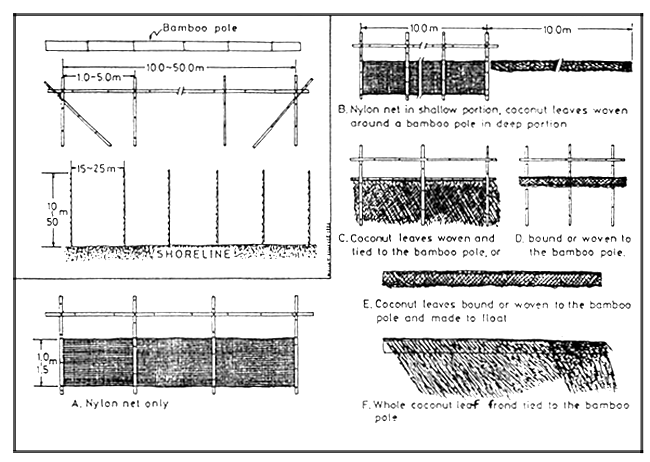
Fig. 1 Milkfish fry barrier or fence, its structure and dimensions(inset), and kinds of materials used(A-F).
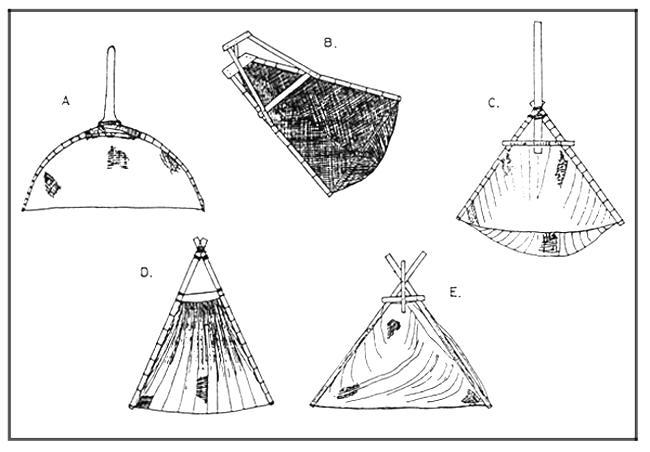
Fig. 2. Different modifications of skimming net.
A series of two to four tidal set nets may be placed across the mouth of a relatively large river. The gear is generally operated by two to five men during flood tide. In some places, the catching operation is continued even during receding tides when milkfish fry swim against the outgoing current. Although this gear has been introduced in Indonesia and Thailand, its use for commercial fry collection is limited to the Philippines.
c. Floating tidal net (Figure 4). The gear consists of V-shaped floating wings made of coconut leaves tied to a bamboo frame. The sides are made of fine mesh nylon netting and the catching chamber is made of abaca cloth. The offshore side of the wing is longer (20 to 30 m) than the nearshore side (6 to 8 m). The opening between the two tips of the wing is from 20 to 30 m. This net is set against longshore currents and is suited particularly to coastal promontories with relatively shallow coralline platforms. In certain areas, several units may be set about 10 to 15 m apart, one in front of the other. The gear is usually operated by one man during flood tide, but operation is continued even during the receding tide when wind or current direction is toward the gear. This method is used only in the Philippines.
d. Push net (Figure 5). This gear consists of a V-shaped bamboo frame provided with a detachable fine mesh nylon netting and a bag net located at the narrow end. Abaca cloth is usually sewn over the nylon netting at the ends of the portion of the bag net to prevent the fry from sticking during the process of concentrating and scooping. The wings and the bag net are weighed down with lead sinkers. The top portions are tied to the frame above the water line, while the lower parts are 5 to 15 cm below the water surface. The gear is usually operated along the shore or river banks by two people; one pushing the gear and scooping the fry from the bag net, and the other shuttling and sorting the fry. In some areas, the push net has bigger dimensions and is provided with a platform for basins and pails. In this case, one person pushes the gear while the other pulls it with a rope form the shore. The push net is also used in a stationary position along the shore or river mouth and is operated like the tidal net set. On stormy days, push nets are set against the surf. The push net has been motorized in some areas in Taiwan and in the Philippines. In the Philippines, it is modified by replacing the wings with bigger mesh size nylon netting (4 mm) to reduce water resistance. The net is then attached to one side of a pump-boat with a 10 to 16 hp engine and used in the deeper portion of fry grounds. The push net has been demonstrated in Indonesia, but there is no report indicating whether it has been adopted by local fry collectors.
e. Push net with bamboo raft (Figure 6). This gear is similar to the push net described above except that it is provided with a bamboo raft. The wings are made of matted bamboo attached to whole bamboo logs which serve as floats. The bag net is made of abaca cloth. This gear is usually operated in fry grounds with extensive shallow intertidal waters up to 5 m deep. Two people are needed to operate it. One person pushes the gear with a bamboo pole while the other scoops and sorts the fry. This method is usually undertaken at night until early morning (21:00 to 04:00 h), with a lamp being used to facilitate catching and sorting of fry. At times, this gear is set along the river bank and is operated like the tidal set net. This gear and method have been reported only in Panay Island, Philippines. However, motorized push nets with bamboo rafts are common in Taiwan.
f. Tow net with bamboo floats (Figure 7). This gear is also similar to the push net, but, instead of a rigid bamboo frame, two bamboo poles are used as floats. The wings and bag net are made of fine mesh nylon netting; abaca cloth is sewn over the scooping end of the bag net. The mid-front section of the bag net is provided with a series of lead sinkers. Each wing-end is attached to a bamboo pole to facilitate towing and to keep the wing in an upright position while in operation. This gear is towed along the shore by two people, one at the free end of each wing. When one of the operators takes the fry to shore, the other continues towing by holding the free ends of both wings.
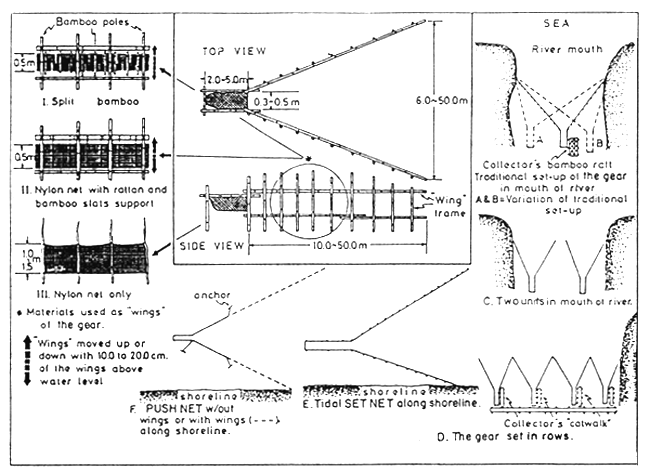
Fig. 3. Tidal set net, its structure and dimensions(inset), wing materials (I-II), and variations in setting up(A-F).
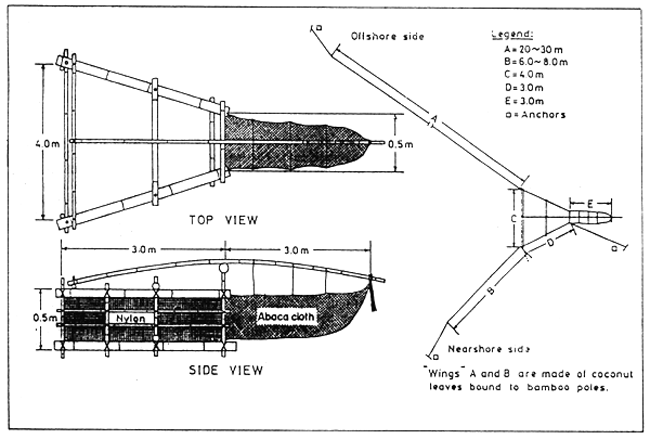
Fig. 4. Floating tidal set net, its structure, dimensions and how it is set up.
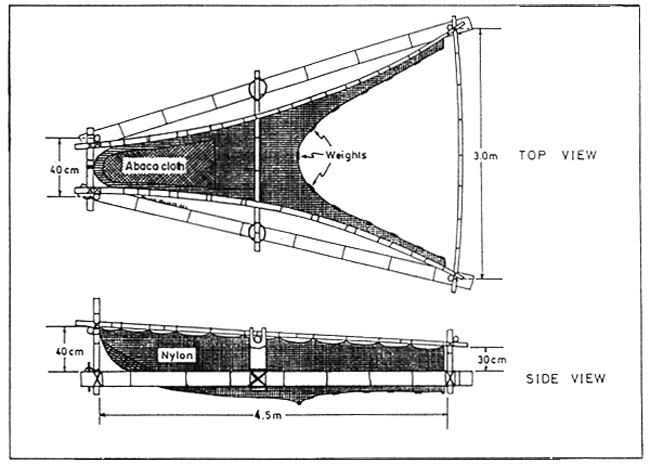
Fig. 5. Push net, basic type, its structure and dimensions.
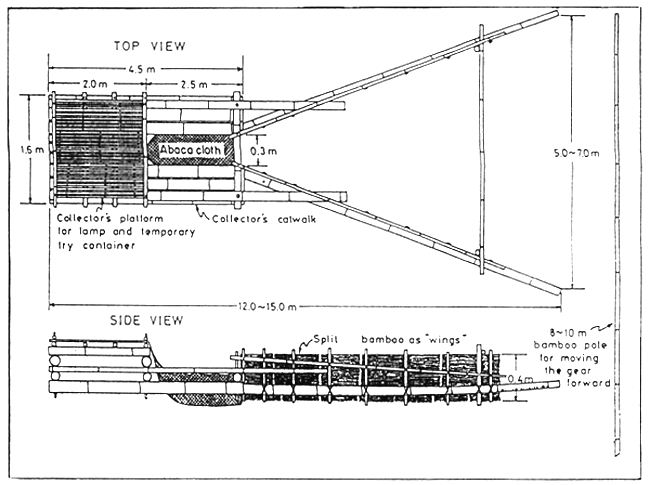
Fig. 6. Push net with bamboo raft, it structure and dimensions.
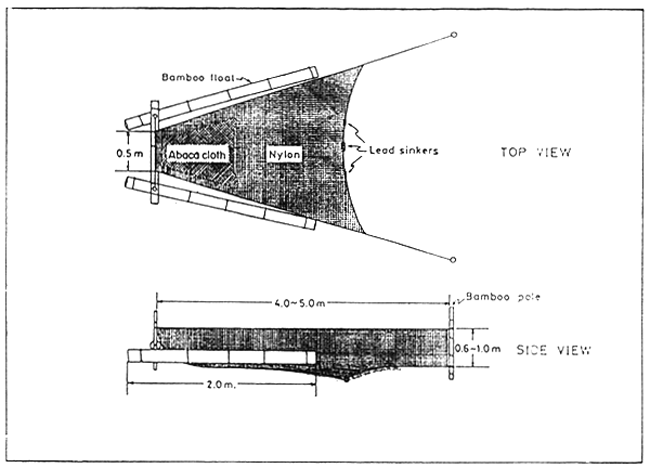
Fig. 7. Tow net with bamboo floats, its structure and dimensions.
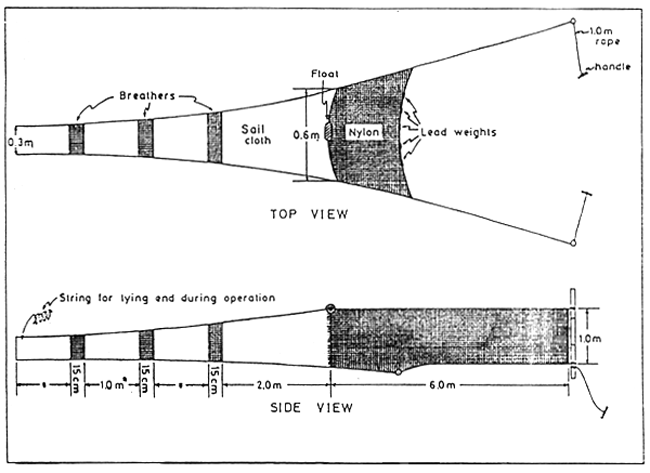
Fig. 8. Tow net, its structure and dimensions.
This gear is also used in rivers or creeks, either mobile or operated like a tidal set net. This method has been used only in southern Luzon, Philippines.
g. Tow net (Figure 9). This gear consists of wings made of fine mesh netting and a cylindrical bag made of sail cloth. A float is attached at the upper mid-portion of the bag net's opening, while the lead sinkers are placed at the lower edge. Each wing-end has a bamboo pole with a 1.0 m nylon rope tied to the lower portion of the pole. This keeps the wings in a vertical position when the gear is subjected to an undercurrent. The tow net is used in areas with steep shore profiles, high waves and stormy winds. Two people operate it, each pulling on the bamboo pole at the end of one wing. The filtered fry are concentrated at the cod end; the strings at the cod end are untied and the fry are poured into a plastic bag. The tow net can also be operated like a tidal set in places where a sandbar has formed parallel to the shore or at the mouth of a river or creek. This gear and method have been reported only in the Philippines, but have been recently introduced to Sri Lanka and Panama.
Seine Nets
a. Double stick net (Figures 9 and 10). This gear usually consists of a rectangular abaca or organdy cloth section (1.0 to 1.5 m wide and 4.0 to 6.0 m long) suspended between side bamboo poles. This is towed along the shore or at the river mouth by two people. Various modifications have been made to the original design because of the cost of materials, prevailing local conditions, and mode of operation. Modifications include using fine mesh nylon netting at the wings while retaining abaca cloth in the center portion where the fry are concentrated and scooped. In fry grounds with moderately steep shore profiles, the bamboo poles at one or both ends are replaced with rope loops, allowing the collector to swim with the net. A smaller version of the double stick net is used by children, mostly in shallow rivers or creeks. This type of gear is used in all countries where milkfish fry are abound.
In Sri Lanka, milkfish fry and fingerlings in pools at the higher marsh level of coastal wetlands are also collected with the double stick net. The area is first searched for schools of milkfish. The collector then scares the fish with shadows cast by waving hands. This drives the school to more shallow areas and the gear is towed toward the school when the fish have formed a “ball”. The fish are concentrated at the center of the gear and transferred to a container with a bowl.
b. Fry seine net (Figures 11 and 12). This gear consists of equal towing lines at both ends of coarse mesh (1.6 mm) nylon netting with abaca cloth sewn over the center. The gear is provided with a series of floats at the top and lead sinkers at the bottom. Two people operate this net, one staying on the shore holding one end of the towline while the other casts the gear 50 to 100 m from the shore with the use of a small boat. The fry are concentrated and scooped at the shore. The fry seine net is usually operated near river mouths during low tides and neap tides and set consecutively or repeatedly until the catch becomes minimal. This gear has been modified with a bag net at the center similar to the tow net with bamboo floats. The wings are longer and made entirely of fine mesh nylon netting. Four people are required to operate this modified version, which is used only in Antique Province, Philippines.
Storage of Fry
The whole catch, which may include other fish fry and crustacean species, is brought to shore after capture. It is then transferred to an earthen jar, a white basin, a water-tight bamboo basket, or a palm basket. A small cup, bowl or shell is used for counting and sorting. The counted fry are placed in another container while debris, dead fry and unwanted species are discarded. In the Philippines, a cylindrical device made of nylon netting is utilized to sort fry if undesirable organisms are numerous.
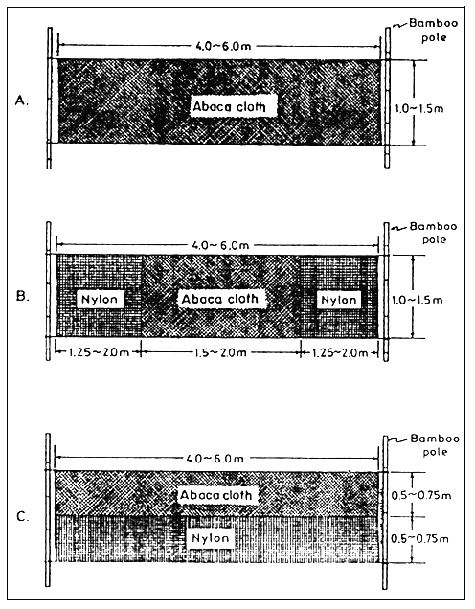 | 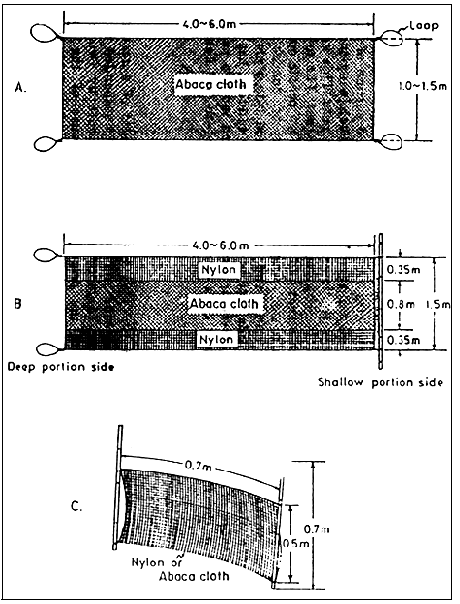 |
| Fig. 9. Modifications of double stick net. | Fig. 10. Modifications of double stick net. |
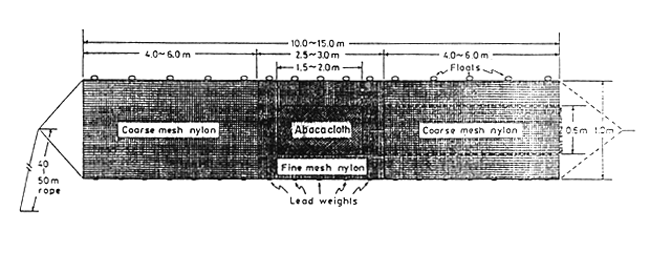
Fig. 11. Fry seine net, structure, dimensions and materials used in the construction.
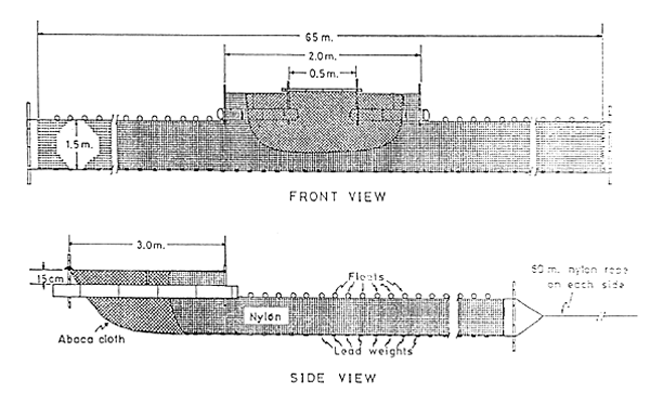
Fig. 12. Modified fry seine net, its structure and dimensions.
Fry of tarpon (Megalops cyprinoides) and ten-pounder (Elops machnata) look very similar to milkfish larvae. They are voracious predators of milkfish fry and fingerlings in the nursery pond. Both can be distinguished from the milkfish be their longer and wider bodies, swimming movements and light amber color.
An actual head count is done when fry are few, but when the catch runs into several thousands, counting is done with the aid of pebbles, shells or any suitable material. One small pebble or shell represents 100 fry, while a bigger one represents 1,000 fry. Another method of counting is done by visual estimation; the density of fry in one container is compared with density of fry of a known number in another container.
The fry are not fed during overnight storage after being caught. The storage water generally is diluted with freshwater. In the Philippines, the ratio of dilution is three parts seawater to one part freshwater. The fry, now in oxygenated plastic bags, earthen jars, or bamboo and palm baskets (10 to 30 1 capacity) pass to a dealer and a longer-term storage follows. The water in the storage container (20 to 30 1 capacity) is diluted again at ratios of one part seawater to one part freshwater to approximate 20 to 25 ppt salinity in the Philippines, and one part seawater to four parts freshwater in Indonesia. Another method of obtaining the desired water medium for fry storage in Indonesia is by mixing salt with freshwater to obtain a salinity of 10 ppt. The fry containers are then covered to minimize fry activity and to prevent dirt from entering the containers.
Food, such as the yolk of hard boiled eggs, whole poached eggs, pulverized rice, or dried wheat flour, is given to the fry either daily or every other day. The storage containers are inspected every morning and afternoon; the excess food, faeces, dead fry and debris are removed. Before cleaning, the water in the container is swirled by hand to concentrate the unwanted materials at the center. A bowl or shell is then used to scoop out these potentially toxic wastes. Every day or every other day, storage water is either completely or partially replaced with new water premixed at the desired salinity level.
Fry stored for more than 15 days are usually weak. Very low survival is obtained when these are stocked in the nursery pond. The condition of the fry may be determined by the following procedures:
Observe the fry closely. Strong and healthy fry move continuously in the same direction along the wall of the container. If the fry display this behavior only occasionally or swimming is sluggish, the fry are weak.
Swirl the water. Healthy fry will swim against the current.
Tap the container or move a hand over it. Fry that react with a quick diving movement are in good condition.
Some dealers in the Philippines and Indonesia keep fry alive and in reasonable condition for one to three months by storing them in earthen jars (20 to 30 1 capacity) and reducing the stocking density to a few hundred per container.
Mortality of fry while in storage may be caused by one or more of the following : physical injuries during catching and handling; overcrowding; water fouling caused by decomposition of food, faeces, dead fry, debris, and high bacterial load of storage water; temperature and salinity shock; starvation; storage of longer than 15 days in relatively crowded conditions; and predation by other fish species.
Transport of Fry
The fry are not fed before transport. The storage containers are cleaned and the water is completely replaced. The fish are transferred to smaller basins and their number determined by visual estimation. Freshwater is usually added to reduce the salinity. In the Philippines, the ratio is one to two parts freshwater to two parts storage water, and in Indonesia, nine parts freshwater to one part seawater is common. Excess water is removed with a small bowl, shell or cup held over a scoop net or nylon netting to exclude the fry. The fry are introduced inside double plastic bags. Oxygen is added at a volume of ½ to ⅔ of the water in the bags. The bags are then placed inside palm bags or cardboard boxes if they are transported by land, or inside styrofoam boxes of jerricans in the case of air transport. Transport by boat using earthen jars or bamboo baskets as fry containers is the usual practice in Indonesia. Since it takes three to seven days for the fry to reach their destination, water in the container is changed and the fry fed daily.
In Sri Lanka, the fry are placed directly into double cylindrical plastic bags containing one part lagoon water diluted with one to three parts freshwater. Each bag contains about 4 to 6 1 of water and 8 to 12 1 of oxygen. The bags are not placed in containers as in other countries; they are simply arranged vertically inside a jeep or van.
Acclimation and Stocking of Fry
Upon delivery to the fish pond, the milkfish fry are usually transferred to another container (20 to 30 1 capacity) for conditioning, final counting and sorting. The water in the conditioning container is diluted about 25% with pond water 4 to 6 hours after arrival. This is repeated every 2 to 4 hours until the salinity more or less equals that of the pond. Most fish farmers stock fry directly from the container to the pond, while others let the container float in the pond for about 10 to 15 minutes to further reduce temperature differences. The survival rate is 95 to 100% after one day of stocking. If the fry are stocked directly upon arrival, the transport containers are made to float in the nursery while the transport water is gradually diluted or replaced with pond water. The fish are released into the nursery 15 to 20 minutes after arrival and survival after stocking is from 20 to 100%.
Jesus V. Juario
University of the Philippines,
Cebu City, Philippines
Introduction
Milkfish culture was introduced into the Philippines probably more than 300 years ago from Indonesia or China (Herre and Mendoza, 1929). Since then, it has been cultured in brackish water ponds. In the early 1970s, milkfish culture in pens began in Laguna de Bay, a freshwater eutrophic lake (Delmendo and Gedney, 1974). This was found to be very successful and commercially viable.
Intensity Of Culture
In the Philippines, the level of intensity of milkfish culture may be categorized into “traditional” and “extensive” management.
Traditional management:
This is the lowest level of production. The ponds are very large, difficult to manage, not completely cleared of mangroves, and poorly designed and constructed. The bottom is irregular and dikes are low and weak. There are no nursery ponds, and no properly designed canals and gates. Inputs, if there are any, are minimal during operations. Milkfish feed only on naturally occurring food. Fertilizers are not used to stimulate production of natural food. Harvest is difficult and incomplete. Traditional fishfarms in the Philippines may produce from 100 to 400 kg per ha per year, but they are fast disappearing.
Extensive management:
This is categorized into extensive and improved extensive management.
Extensively managed ponds are still incompletely cleared of mangroves. The bottom is not levelled and mangrove stumps are not removed. Canals and nursery ponds are not well developed but wooden gates are installed for water management. Fertilizers of low quality and in small quantities are used to stimulate production of natural food consisting of either lablab or lumut.
In improved extensive management, the ponds are well designed and constructed, completely cleared of mangrove stumps and the bottom is levelled. Canals and nursery ponds are well developed and either wooden or concrete gates are installed for efficient water management. Harvesting is easy and is usually complete. Fertilizers of high quality and in larger quantities are used to stimulate growth of natural food consisting usually of lablab and sometimes plankton. Fish are sometimes given supplemental feeds.
Pond Types for Different Culture Systems
Traditional milkfish pond system (Figure 1)
In this system the nursery ponds represent 1 to 10% of the total area, the transition ponds 10–20%, the rearing ponds 70 to 80% and the dikes and canals 5%.
The nursery pond is a small pond used for rearing fry to fingerlings. This is usually located in areas which can be supplied easily with freshwater and which can be drained easily even during ordinary tides. A manageable compartment ranges from 100 to 2,500 m2.
At the transition pond, fingerlings are reared or stunted until they are ready for stocking in rearing ponds. This is located adjacent to or near the nursery pond for easy transfer of stock. A manageable compartment ranges from 2,500 to 15,000 m2.
The rearing pond is where fingerlings are raised to marketable size. It is the largest compartment of the pond system. The most manageable area ranges from 2 to 5 ha.
The catching pond is optional. This serves as a catchment basin during harvest and is located near the pond gate.
The feed pond is also optional and is generally found in areas where natural food does not grow well. A nursery or transition pond may be used for this purpose. This is located near the pond which needs supplementary food.
Modular pond system (Figure 2)
This is an improvement of the traditional system. The ponds are easier to manage and production is significantly higher. The rearing ponds are divided into three production modules using three compartments with an area ratio of either 1:2:4 or 1:3:9, thus allowing for a continuous program of pond preparation and harvest. The nursery ponds represent 4 to 10% and the transition ponds, 6% of the production area.
Pond Preparation
Pond preparation for both the traditional or modular pond system is the same. Its main objective is to provide a pond environment free of pests and predators and a pond bottom suitable for growth of natural food. Although different ponds require different forms of pond preparation, it generally consists of various phases. These include pond draining, tilling and levelling, eradication of pests and predators, liming and natural food production
Pond draining, tilling and levelling:
As soon as the pond is drained, the bottom is tilled, using a rake, rotavator or hand tractor, or plowed, using a carabao or water buffalo. This brings nutrients in the bottom soil to the surface layer. The bottom is graded so that it gradually slopes from the farthest end to the gate to facilitate removal of wastes during flushing and total drainage during harvest. In addition, pests and predators, which reduce milkfish production, are eliminated or controlled either by mechanical or chemical eradication methods.
Eradication of pests and predators:
Pests and predators that reduce milkfish production, are eliminated or controlled either by mechanical or chemical methods.
- Mechanical Methods:
Eradication by mechanical methods involves draining the pond completely and drying it for one to two weeks or until the bottom cracks. This eliminates most pests and predators that burrow into the mud.
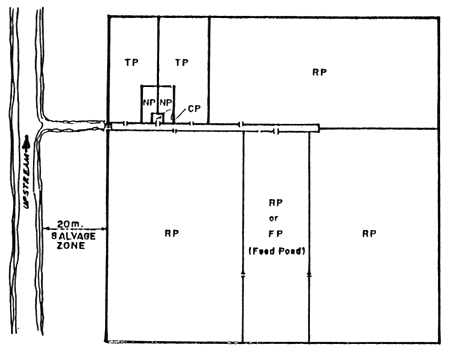
Figure 1. Traditional pond system (Source: Baliao, 1983)
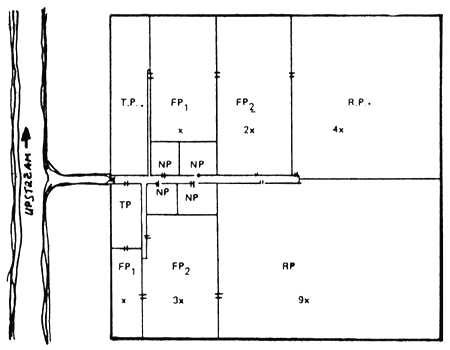
Figure 2. Modular pond system (Source: Bangos Technical Committee, 1983). Legend: NP Nursery pond; TP - Transition pond; FP - Formation pond; RP - Rearing pond; CP - Catching pond.
It also eliminates harmful wastes like hydrogen sulfide resulting from organic matter decomposition.
In order to screen out pests and predators, bag nets, bamboo screens or filter box screens are installed either singly or in combination at the water supply gate. Leaks in screen filters, gates and dikes are repaired and snails and other organisms that congregate in watered areas are manually removed.
- Chemical methods:
These are necessary when the ponds or some areas of the ponds can not be drained completely. Organic or inorganic pesticides, and some inorganic chemicals, are used to eliminate pests and predators.
The most commonly used organic pesticides are rotenone, tobacco dust and tea seed cake.
Rotenone is the active component of derris root. It is applied at a concentration of 3 to 5 ppm at a water depth of about 10 cm. If it is not available, a root extract is prepared. The roots of a plant one to two years old are soaked in tap water overnight. These are then pounded thoroughly and squeezed and rinsed in the water used for soaking to extract the rotenone. About 20 to 40 kg roots per ha are applied to a water depth of about 10 cm. In the Philippines, the sources of rotenone include: Derris elliptica, Derris heptophylla and Derris philippinensis.
Tobacco dust and other wastes are by-products of cigarette production. Tobacco dust is applied at 200 to 400 kg per ha. Sacks containing tobacco dust are soaked in tap water overnight. This is spread as uniformly as possible over the pond bottom after which water is admitted to the pond and maintained at a depth of 10 cm for one to two weeks.
Tea seed cake is a by-product of processing the tea plant, Camellia sp. The seeds of the plant contain saponin, which is effective in eliminating undesirable fishes or vertebrates. It is ineffective on invertebrates. Tea seed cake is soaked overnight in tap water and then applied at a concentration of 15 ppm at 10 cm water depth.
Some farmers still use the following inorganic pesticides to eliminate undesirable species: endrin at 200 ml per ha, gusathion at 250 ml per ha, brestan at 150 ml per ha, and aquatin at 300 ml per ha. These are applied in ponds with an average water depth of 5 cm. When using inorganic non-biodegradable pesticides, it is necessary to carefully read and strictly follow the instructions on the containers. Inorganic pesticides, are used only when necessary, because of their negative effects.
Aside from pesticides, some inorganic chemicals are used to eliminate pests and predators. One commonly used chemical is ammonium sulfate, applied at a concentration of 100 to 200 kg per ha at 5 to 10 cm water depth. The toxicity is enhanced if calcium oxide (burnt lime) is applied at 500 to 1,000 kg per ha just before the ammonium sulfate is applied. Ammonium sulfate is scattered over watered areas when it is not windy to avoid significant loss of the chemical.
Liming:
Lime is applied to ponds to make the soil pH neutral or alkaline and to hasten volatilization of ammonia. The response to fertilizer application is best if the pH of pond soil lies within the range of 7.5 to 9.5. As a rule of thumb, 1,000 kg per ha of calcium hydroxide (Ca(OH)2) is applied to new ponds during the first year of operation. This is spread evenly over the pond bottom, sides and dikes. For old ponds, 500 kg per ha of calcium carbonate (CaCO3) is spread over the pond bottom. For acidic ponds with pH below 5, calcium oxide (CaO) is applied at 1,000 to 2,000 kg per ha. For maximum effectivity, lime is mixed or worked into the soil by raking or plowing. The most accurate way to determine lime dosage is by using the table of lime requirement for fishponds provided by Boyd (1974).
Natural food production:
Three types of natural food are produced in brackish water ponds, namely: lablab, lumut and plankton.
- Lablab production:
Lablab is a complex of minute plants and animals occurring initially on the pond bottom as a brownish, greenish or yellowish film. It grows well during the dry months in ponds with hard bottoms and salinities ranging from 25 to 35 ppt. In order to produce lablab, chicken manure is scattered, at a rate of 2 mt per ha, over previously dried ponds from one to four years old, or at 0.5 to 1 to ponds at least five year old. Sufficient water is then admitted to barely cover the pond bottom. Two to three days later, inorganic fertilizers consisting of 100 kg per ha of 16–20-0 or of 50 kg per ha of 18–46-0 and 25 kg per ha of 45-0-0 (urea) is applied. Then 5 cm of water is admitted every three days until the water depth reaches 25 to 30 cm. An abrupt increase in water depth will cause lablab to detach and float. Additional inorganic fertilizer consisting of 16:20:0 is broadcast every 7 days at 15 kg per ha but within three days before stocking fish to ponds. Fish production in ponds with lablab ranges from 1.5 to 3 mt per ha per year.
- Lumut production:
Filamentous green algae or lumut of the species Chaetomorpha linum, Cladophora sp. and Enteromorpha intestinalis grow well during rainy seasons in ponds with soft bottoms. Since lumut is poorly digested by milkfish fry and fingerlings (Chiu and Benitez, 1981; Benitez, 1984) it is usually allowed to decompose or dry before it is fed to milkfish. Lumut is produced in the same manner as lablab but the water depth ranges from 40 to 60 cm. Excessive growth of lumut is undesirable because it competes with milkfish for living space. Fish production in ponds with lumut ranges from 0.2 to 0.5 mt per ha per year.
- Plankton production:
Plankton refers to the microscopic plants (phytoplankton) and animals (zooplankton) suspended in water. This is not as widely produced as lablab and lumut because it requires greater water depth, from 70 to 100 cm. To produce plankton, 70 to 100 cm of water is admitted to a previously drained and well prepared pond. Inorganic fertilizers consisting of 18:46:0 at the rate of 22 kg per ha and 16:20:0 at 25 kg per ha or 6:20:0 at 25 kg per ha and 0:20:0 at 25 kg per ha are directly placed on a platform or in a sack which is then placed on a platform. Fertilizer is added while or after admitting water to the pond. Plankton blooms, characterized by the greening of pond water, occur within one or two weeks. When plankton blooms, the Secchi disc visibility is from 15 to 40 cm. The same organic fertilizers at the same dosage applied bi-weekly will maintain Secchi disc visibility at 20 to 30 cm. Fertilization is stopped two weeks before harvest. Fish production in ponds with plankton ranges from 1.5 to 3 mt per ha per year.
Stocking Practices
In the traditional pond system, nursery ponds with abundant lablab are stocked with 30 to 50 fry per m2; transition ponds with 10 to 15 fingerlings per m2. Rearing ponds with lumut are stocked with 500 to 1,000 fingerlings per ha; those with lablab with 1,500 to 3,000 fingerlings per ha; and those with plankton with 3,000 to 5,000 fingerlings per ha.
In the modular pond system, the nursery and transition ponds are stocked with the number of fry and fingerlings required for the rearing ponds throughout the whole rearing period, since the operations are continuous. In determining the approximate number of fry needed throughout the year, an allowance for a 50% mortality rate for fingerlings is considered.
Acclimation Practices
Temperature and salinity differences in pond and transport water are two of the most common causes of fry mortality during stocking in nursery ponds. To minimize mortality, the salinity and temperature of transport water are brought closer to those of pond water before the fry are released into the pond.
If salinity differences exist, fry are acclimatized indoors by gradually adding pond water to the fry container until the salinity of pond and transport water is more or less the same. Acclimation time may extend from 3 to 4 hours. Water salinity is determined by using a refractometer or hydrometer.
If temperature differences exist, the fry containers are left to float in pond water for a few minutes. Then the pond water is gradually added to the container to equalize temperature of the pond and transport water before releasing fry into the pond.
Time and Method of Stocking
Nursery ponds:
The best time to stock fry in the nursery pond is either early morning or late afternoon. During stocking, the fry containers are partially submerged and tilted to one side to allow pond water to flow in. When the container is full, the fry are allowed to swim out.
Sometimes, the fry are kept in small shaded acclimation ponds built within the nursery ponds and reared on rice bran, patches of lablab or egg yolk. Generally, a density of 4,000 to 5,000 fry per m2 is used in the acclimation pond. After one week, the fry are released into the nursery pond by breaking the dikes of the acclimation pond.
Transition ponds:
When transferring stocks from the nursery to the transition pond, the nursery pond is partially drained at low tide. As water enters the nursery pond at high tide, the fingerlings will swim towards the inflowing water out into a confined area in the supply canal. A large seine net is used to collect the fingerlings. The fingerlings are scooped out and transferred to the rearing pond.
Rearing ponds:
The same method is used to transfer fish from nursery and transition ponds to rearing ponds. Another method uses the water partially stored in the rearing area. Water is allowed to flow into the area where the fish are confined. By swimming against the flowing water, the fish enter the rearing pond through a one-way device fixed at the gate.
Water Management
Maintenance of good water quality in the pond is one of the keys to successful culture. The water depth for culturing milkfish with lablab as the natural food is as follows: 20 to 30 cm for the nursery, 30 to 40 cm for the transition, and 40 to 50 cm for the rearing ponds. When lumut is used as food, 20 to 60 cm water depth is maintained in rearing ponds; if plankton, 70 to 100 cm.
About 30 to 50% of the pond water is changed during full and new moon periods or every 14 days. Ponds are drained either late in the evening or early in the morning about 2 to 3 hours before an incoming high tide. Pond water is not drained to a level lower than the expected tide level for that particular day.
Supplemental Feeding
When lablab or lumut is depleted or overgrazed a few days before harvest, rice bran, bread crumbs, and other feeds are given at 4 to 10% of the average body weight to maintain growth. The first half of the ration is given in the morning; the other, in the afternoon. Some farmers give artificial feeds to fatten fish before harvest.
Grow-out Culture
There are three cropping systems practiced in the Philippines: the straight culture, the progression and the modular methods.
In the straight culture method, the fingerlings are stocked and reared to marketable size in one rearing pond for two to four months. Farmers practicing this method may face the problem of food depletion in ponds before harvest.
In the progression method, fingerlings are reared to marketable size in two different ponds: fingerlings to post-fingerlings in one pond and post-fingerlings to marketable size in another. In this case depletion of natural food in ponds before harvest is circumvented.
An improvement of the progression method is the modular method. The fish are reared successively in three different ponds connected to one another and with progressively increasing areas in a 1:2:4 or 1:3:9 ratio. The stock is reared for 45 days in the first pond and subsequently transferred to the second and third ponds. The vacated pond is immediately prepared for the next stock. Since the three ponds are connected to one another, the fish are transferred from one to the next with minimum handling. By using this method, farmers can harvest fish six to eight times a year.
Harvest
When milkfish reach marketable size (250–300 g), they are harvested by using either total drainage or the current method. In the first case, the fish harvested have a muddy taste or small because it is very difficult to remove completely the mud that adheres to the fish. Because of this, very few farmers use this method.
The current method is the same method used in transferring stock from one pond to another in a modular pond system. This method takes advantage of the tendency of milkfish to swim against the current. Water in the rearing pond is partially drained during low tide. At high tide, water is admitted into the rearing pond. By doing this, the fish will swim into the catching pond through the gate. When the majority of the fish are in the catching pond, the gate is closed. The fish are then seined or scooped. The few remaining fish are harvested after totally draining the pond.
Fishpen Culture
Fishpens are constructed in shallow eutrophic lakes. They are located outside navigation lanes in sheltered areas with a water depth of at least 1.5 m at the lowest water level. They consist of an enclosure net and a supporting framework (Figure 3), usually made of bamboo poles. Sometimes wooden posts and trunks of the palm tree, Livistonia rotundifolia, locally known as “anahaw” are interspersed with the bamboo poles. The usual netting materials are synthetic fibers like nylon and polyethylene. The mesh size of the nets is important. For a barrier net, the mesh size is 152 mm stretched or 8 × 8 cm, for a pen enclosure, 22 mm stretched or 1 × 1 cm, and for a nursery, 10 mm stretched or 0.5 × 0.5 cm..
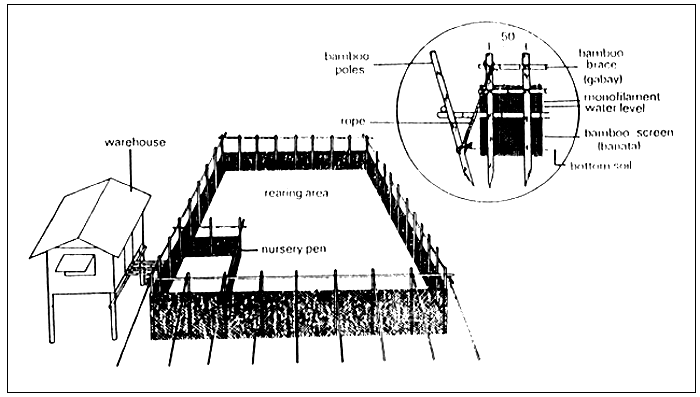
Figure 3. Fishpen culture set-up. (Source: Baliao, 1984)
Fishpens are either circular, square or rectangular. Ordinarily, there are only two compartments, the nursery and the grow-out areas. The nursery comprises about 10% of the total area of the pen.
In Laguna de Bay, fingerlings are stocked at 20,000 to 30,000 per ha in the grow-out compartment. The culture period varies from four to ten months, depending upon the temperature. The culture period is shorter during warm months and longer during cold months. Some operators stock their pens once a year usually in May or June while others stock twice a year, in March or April and again in July or August.
Fishfarmers usually stock in the nursery compartment fingerlings that are 6 to 7.5 cm in total length. These are bought from commercial nurseries and transported early in the morning or late in the afternoon to the pens in either oxygenated bags or in specially designed fish boats locally known as petuya. During transport in the petuya, the fingerlings are gradually acclimated to the pen conditions through the water exchange system. To avoid high mortality, the fingerlings are transported in petuyas only during good weather.
Pen Preparation and Management
Undesirable species such as gobies, catfish, and water snakes are eliminated from the nursery and rearing compartments by using seines and gill nets. The fingerlings are reared in the nursery and given supplemental feed consisting of rice bran twice a day at 5% of the mean body weight. They are kept in the nursery for one to two months or until they reach the average total length of at least 12 to 13 cm. Thereafter, they are transferred to the rearing compartment. Some operators give supplemental feed during cold months or two weeks before harvest to fatten the fish. The quantity of feed is only roughly estimated.
The nets are regularly inspected. The portion that is constantly submerged is thoroughly inspected for holes and then immediately repaired. The portion that is constantly exposed to dryness becomes brittle or worn out and is changed after harvest.
Guardhouses are constructed in a strategic part of large pens to prevent poaching.
To prevent mass mortality due to oxygen depletion, as evidenced by fish on the surface gasping for air, operators run motorized bancas inside the pens to agitate and aerate the water.
Harvesting
The seine and gill net are commonly used to harvest milkfish reared in pens. Seine nets are used to harvest fish in large pens covering an area of as much as 5 ha. About 15 to 20 men are needed to operate the seine. Gill nets are used to harvest fish in small pens or to harvest fish after seining. As fish caught by gill nets have to be untangled, gill netting is therefore, laborious. Harvesting 0.5 to 1 mt of fish by gill netting can easily take five hours or more.
Acknowledgment
I wish to thank Messrs Antonio Villaluz and Renato Agbayani for critically reviewing this manuscript.
References
Baliao, D.D. 1984. Milkfish nursery and pen culture in theIndo-Pacific Region. In J.V. Juario, R.P. Ferraris and L. V. Benitez (eds), Advances in Milkfish Biology and Culture. Island Publ. House, Inc., Metro Manila, Philippines, pp. 97–106.
Bangos Technical Committee. 1983. The Philippine recommends for bangos. Philippine Council for Agriculture and Resources Research and Development. 2nd ed. 77 pp.
Benitez, L. V. 1984. Milkfish nutrition. In J. V. Juario, R. P. Ferraris and L. V. Benitez (eds), Advances in Milkfish Biology and Culture. Island Publ. Hourse, Inc., Metro Manila, Philippines, pp. 133–143.
Boyd, C. E. 1974. Lime requirements of Alabama fishponds. Bull. No. 459, Auburn Univ. Agricultural Experimental Station, Auburn, Alabama. 20 pp.
Chiu, Y. N. and L. V. Benitez. 1981. Studies on the carbohydrates in the digestive tract of the milkfish, Chanos chanos. Mar. Biol. 61: 247–254.
Delmendo, M. N. and R. H. Gedney. 1974. Fish farming in pens, a new fishery business in Laguna de Bay. LLD Tech. Paper No. 2, 77p.
Herre, A. W. and J. Mendoza. 1929. Bangos culture in the Philippine Islands. Phil. J. Sci. 38: 451–509.
Tukabu Teroroko
Fisheries Division,
Bikenibeu, Tarawa,
Kiribati
Introduction
The farming of milkfish (Chanos chanos) at the subsistence level in Kiribati is an old tradition carried out at several locations by governmental or private initiative.
Milkfish production supplies the local need for baitfish, mainly for the pole and line tuna fishing industry, as well as a food source for the village communities.
Milkfish production for baitfish is carried out under extensive, semi-intensive, and intensive conditions.
Baitfish Production
Extensive baitfish production
In the extensive method, after a repeated seine-netting of the pond to remove the old fish stock, the sluice gate screens (0.5 cm netting) are cleaned to allow fry to freely enter into the pond. The fry, approximately 15 mm in length, are not given supplementary feed. To minimize the number of oversized fish and maintain a standing crop of baitfish, fish are harvested every four weeks. By following this procedure, 15 mm fry usually reach bait-size (110 mm in length) within 12 weeks.
Before the outbreak of Tilapia, over 1,000 kg per year of baitfish could be produced. At present, the milkfish production from this method ranges between 270 and 1,540 kg per ha per year.
The use of a proper screen mesh size is essential to permit free entry of the fry and, at the same time, prevent the escape of baitfish.
Semi-intensive baitfish production
As described for the extensive production method, the pond is prepared by netting over sized fish and allowing free entry of wild fry. However, additional fingerlings (20 to 35 mm in length) are stocked artificially after each harvest. In addition, supplementary feeding is provided using copra cake mixed with fish meal or chicken pellets at the rate of 3% of body weight per day. For the feeding operation, simple broadcast or the use of feeding trays produces suitable results.
By following this procedure, the production levels may be increased between 480 and 2,900 kg per ha per year.
Intensive baitfish production
Owing to the outbreak of Tilapia at Temaiku Fish Farm in 1982, an intensive culture system was developed. The major input required for this culture method includes rotenone (at the rate of 4 ppm) to eradicate Tilapia and organic fertilizer, such as chicken manure (at the rate of 2 mt per ha), to increase the productivity of the ponds. The dead Tilapia are not removed but allowed to decay in order to increase fertilization. Under these conditions, lablab develops after two or three weeks.
To avoid the spread of poison to other ponds via the feed canal, it is important to completely seal the sluice gates with pond mud. This also prevents the natural ingress of wild fry that could further increase milkfish population in the pond.
Advanced fingerlings (20 to 35 mm in length) from the nursery pond are stocked at the rate of 30,000 fry per ha once lablab is formed in the rearing pond. The ideal time to stock fry is during the cool hours of the morning.
Usually, no additional input of fertilizer or food is necessary during the rearing period except when a poor growth of lablab occurs due to, for example, an excessive amount of sand in the chicken manure. In this case supplementary feed is added on feeding trays.
Bait-size milkfish (7 to 10 cm total length and 8 to 12 g body weight) are obtained within 8 to 10 weeks.
In the intensive method of culture, the production reaches 4,500 kg per ha per year and the mortality rate recorded is approximately 35%.
Culture of Milkfish as “Foodfish”
To culture of milkfish for human consumption, bigger ponds of 3 to 7 ha (including the canal) are used. The fish to be stocked are selected during the baitfish harvest. Oversized baitfish (more than 15 cm in length) are released in the canal or in other “foodfish” ponds. Wild fry are also allowed free entry into the “foodfish” ponds. The stocking rate depends entirely on the natural food available in the ponds. However, artificial feed may be added in the feeder canal where most of the oversized baitfish are released. For the feeding operation, the use of “demand feeders” made of empty 200 1 drums in “foodfish” ponds, was found to save time and minimize food wastage.
The “foodfish” population is controlled by using 5 to 6-cm monofilament gill nets.
Milkfish for food consumption are usually harvested when they reach the weight of 150 to 300 g. The harvest may vary from 100 to 300 kg per week depending on orders.
Milkfish-Poultry Integration
An early attempt to raise chickens over milkfish ponds was conducted at the 7 ha pilot farm at Ambo. A chicken house was installed at the pond edge and the wastes washed directly into the pond. The production results attained were very encouraging. However, successive attempts to adopt this technique on a commercial basis at the Temaiku Fish Farm, were unsuccessful due to the competition with local poultry producers. Despite such constraints, adoption of this technique would provide pure chicken manure for better production results, and would avoid waste likely to occur during the transport of chicken manure.
Traditional Milkfish Culture at Nikunau and Beru
The culture area ranges between 7 and 31 ha of natural inland waters 0.3 to 3 m deep. Because ponds are not connected to the sea, they must be stocked with collected fry. Wrapped coconut leaves are used to accumulate and gather the fry. The stocking density is usually based on the number of people living on the island at the time. It is the responsibility of one of the island-appointed families to determine the stocking density necessary to assure a sufficient supply of fish for all the island people. The stocking operation may be carried out at any time of day. Coconut leaves are sometime used to facilitate the “slow” release of fry into the pond.
In these waters large quantities of natural milkfish food, locally called “te meritaua”, occur. No additional input is required during the rearing period other than normal monitoring.
Simultaneously, at the time of stocking, a few fry are raised in smaller extension ponds for growth monitoring. A selected family is usually responsible for the monitoring. In two or three years, milkfish may be harvested using a 25 cm mesh net. The size of the fish is then the size of a small shark, traditionally called a “bakoa” size. The harvesting is usually timed to the Pandanus season.
Production records are not available. Because of the large presence of Tilapia, milkfish stocking operations have been suspended.